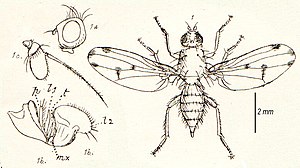Quiver flies
| Quiver flies | ||||||||||||
|---|---|---|---|---|---|---|---|---|---|---|---|---|

Schematic representation of a trembling fly |
||||||||||||
| Systematics | ||||||||||||
|
||||||||||||
| Scientific name | ||||||||||||
| Pallopteridae | ||||||||||||
| Loew , 1862 | ||||||||||||
| Genera | ||||||||||||
|
The trembling flies (Pallopteridae) are a small family of the two-winged flies ( Diptera) and belong to the flies (Brachycera). They occur worldwide with about 60 species, 23 of them live in Europe .
features
The flies are small to medium-sized with a body length between three and six millimeters. They are usually gray, yellow or reddish yellow in color. Your antennae are tripartite.
Way of life
The animals can be found in forests, where they seated let their wings vibrate in a characteristic way. The larvae live as predators under the bark of deciduous trees and hunt there, among other things, bark beetles . But there are also phytophagous species that feed on plants or putrefactive material, e.g. B. some species live in flowers or stems of plants.
credentials
- ↑ Pallopteridae. In: Fauna Europaea. Retrieved April 20, 2007 .
literature
- J. Haupt, H. Haupt: Flies and mosquitoes - observation, way of life. Augsburg 1998.

